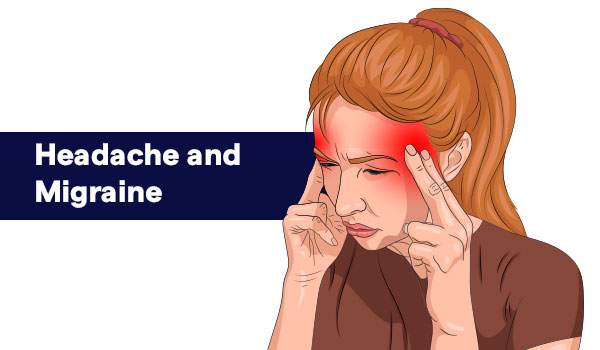Cause of headache and migraine
- Stress: Emotional stress and tension can contribute to headaches and migraines.
- Lack of sleep: Irregular or insufficient sleep patterns can trigger headaches and migraines.
- Certain foods or food additives: Some foods or food additives, such as nitrites, artificial sweeteners, and monosodium glutamate (MSG), can be potential triggers for migraines.
- Hormonal changes: Fluctuations in estrogen levels, especially in women, can trigger migraines.
- Environmental factors: Strong smells, flickering lights, or exposure to smoke can contribute to headaches and migraines.
- Underlying medical conditions: Conditions such as high blood pressure and sinusitis disorders can be associated with headaches and migraines.
Migraine is a neurological condition characterized by recurrent, severe headaches that can last for hours or even days.
Migraine Symptoms
- Headache moderate or severe intensity
- One-sided or behind the eye
- Pulsating in quality
- Aggravated by routine physical activity
- Sensitivity to light and sounds
- Nausea
- There are several types of headaches other than migraines, including tension headaches, cluster headaches, medication-overuse headaches, and the social and economic impact, which are explained below.
Tension-type headache
Tension-type headaches (TTH) are characterized by pressure or tightness around the head, which may migrate to or from the neck.
A significant percentage of populations suffer TTH at some point in time. Episodic TTH bouts typically last a few hours but might last many days. They might be caused by stress or musculoskeletal disorders in the neck. They frequently begin throughout adolescence and afflict 55% more women than males.
Cluster headache
Cluster headache (CH) is a primary headache disease characterized by recurrent (up to several times per day), short but highly intense headaches, generally localized in or around one eye and accompanied by tears and redness. The nose frequently runs or is plugged on the afflicted side, and the eyelids may droop.
Medication-overuse headache
Medication-overuse headaches (MOH) result from continuous and excessive medication use to manage headaches. MOH is the most prevalent secondary headache disease.
Social and economic burden
Migraines and other headaches can impair people's ability to work, resulting in diminished productivity and interpersonal connections. Despite the potentially devastating effects, many people continue to work. Headache-related productivity loss can impact people's jobs and security, finances, relationships, and mental health. It also creates economic losses for businesses and society.
According to research published in the Indian Journal of Psychiatry, the incidence of migraines in India is roughly 14.4%, with women having a higher risk than males. The study also emphasized the impact of migraines on job productivity and quality of life, with many people reporting lost work days and a decreased capacity to execute everyday tasks as a result of their disease.
Despite the high prevalence of migraines in India, many individuals still face challenges in accessing proper diagnosis and treatment due to limited healthcare resources and awareness. The lack of awareness about migraines among the general population and healthcare professionals, as well as the stigma associated with seeking help for mental health issues, contributes to the underdiagnosis.
It is crucial for individuals experiencing frequent or severe headaches to promptly seek medical attention and receive a thorough diagnosis to identify the root cause of their head pain. Treatment for migraines may include:
Medication
In addition to medical treatment, self-care strategies such as stress management, adequate hydration, regular exercise, and proper sleep hygiene can also help manage migraines and reduce the impact of head pain on daily life at the medicine hospital in Delhi.
Furthermore, raising awareness about migraines and advocating for better access to healthcare services for those affected by the condition is crucial in addressing the burden of migraines in India and globally. Collaborating with the public, healthcare professionals, and policymakers to emphasize the importance of early diagnosis and timely treatment of migraines can significantly enhance the quality of life for individuals affected by this debilitating condition.
If you or someone you know is struggling with headaches and migraines, seek help from the Sir Ganga Ram Hospital. Book an appointment with Sir Ganga Ram Hospital for expert diagnosis and treatment of headache and migraine issues.
